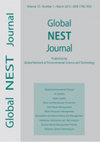Heavy metal accumulation and antioxidant properties of Nephrolepis biserrata growing in heavy metal-contaminated soil
IF 1.2
4区 环境科学与生态学
Q4 ENVIRONMENTAL SCIENCES
引用次数: 10
Abstract
Antioxidant defense mechanisms are crucial for plants to survive under stress conditions. We investigated the capacity of a wild fern species, Nephrolepis biserrata, growing in the vicinity of industrial land to accumulate heavy metals, and assessed its antioxidative response under metal stress. The soils in this particular area were highly contaminated with zinc followed by lead and copper. As control, N. biserrata located 10 km away from the industrial area were collected and assessed. N. biserrata from the contaminated sites accumulated metals in their tissues in similar descending order of zinc>lead>copper. The values of bioaccumulation factor between 0 to 0.1 indicate N. biserrata as a moderate accumulator for the tested metals. For the enzymatic antioxidant assays, the activities of catalase and ascorbate peroxidase were significantly higher in N. biserrata from contaminated soil compared to control, while the activity of superoxide dismutase was not differ significantly in plants from both sites. We also detected higher contents of total phenolics and total flavonoids in N. biserrata collected from contaminated site compared to control. Our HPLC analysis revealed higher levels of myricetin and kaempferol in plant samples from the contaminated area. Our study verified the capacity of N. biserrata to scavenge oxygen radicals when exposed to heavy metal stress. Such ability to tolerate stressful condition suggests that the plant is a potential metal phytoremediator在重金属污染土壤中生长的双色松的重金属积累及抗氧化特性
抗氧化防御机制是植物在逆境中生存的关键。研究了生长在工业用地附近的一种野生蕨类植物(Nephrolepis biserrata)的重金属积累能力,并评价了其在重金属胁迫下的抗氧化反应。这个地区的土壤被锌严重污染,其次是铅和铜。作为对照,收集并评价了位于工业区10公里外的白刺田鼠。来自污染地点的双爪田鼠在其组织中积累的金属元素的大小顺序为:锌b>铅b>铜。生物蓄积因子在0 ~ 0.1之间,表明双色藻对所测金属具有中等蓄积作用。在酶促抗氧化实验中,污染土壤中的双尖茅过氧化氢酶和抗坏血酸过氧化物酶活性显著高于对照,而超氧化物歧化酶活性在污染土壤和对照土壤中差异不显著。从污染地点采集的白刺草中总酚类物质和总黄酮含量也高于对照。我们的高效液相色谱分析显示污染地区的植物样品中含有较高水平的杨梅素和山奈酚。我们的研究证实,在暴露于重金属胁迫下,双胞草具有清除氧自由基的能力。这种承受压力的能力表明该植物是一种潜在的金属植物修复剂
本文章由计算机程序翻译,如有差异,请以英文原文为准。
求助全文
约1分钟内获得全文
求助全文
来源期刊

Global Nest Journal
环境科学-环境科学
CiteScore
1.50
自引率
9.10%
发文量
100
审稿时长
>12 weeks
期刊介绍:
Global Network of Environmental Science and Technology Journal (Global NEST Journal) is a scientific source of information for professionals in a wide range of environmental disciplines. The Journal is published both in print and online.
Global NEST Journal constitutes an international effort of scientists, technologists, engineers and other interested groups involved in all scientific and technological aspects of the environment, as well, as in application techniques aiming at the development of sustainable solutions. Its main target is to support and assist the dissemination of information regarding the most contemporary methods for improving quality of life through the development and application of technologies and policies friendly to the environment
 求助内容:
求助内容: 应助结果提醒方式:
应助结果提醒方式:


